1. Search and select solutions
Historical facts show that, based on the achievements in the 1965-1966 and 1966-1967 dry season campaigns, as well as the victory in the fight against the destructive war in the North, our Party Central Committee had early contemplated the possibility of opening a new battle with the motto: "Fighting while negotiating". However, the domestic and international political situation did not yet ensure the necessary conditions for the implementation of this possibility. By 1967, the 13th Central Committee Conference, held from January 23-26, proposed the policy of stepping up the diplomatic struggle against the US. Resolution No. 155-NQ/TWOn promoting diplomatic struggle, proactively attacking the enemy, serving our people's cause of fighting against America and saving the countrycommented: "In the current international situation, with the nature of the war between us and the enemy, diplomatic struggle plays an important, positive and proactive role. We attack the enemy diplomatically now isright on time”(1). From then on, along with politics and military, official diplomacy was considered an important front,strategiccontribute to the victory of the resistance
That decision opened a new situation for the diplomatic struggle with the initial basic goal of demanding that the US unconditionally and permanently end the bombing and all other acts of war against the Democratic Republic of Vietnam. Implementing the above policy, on January 28, 1967, in an interview with Australian journalist W. Burchet, Foreign Minister Nguyen Duy Trinh declared: “Only after the US unconditionally and permanently ends the bombing and all other acts of war against the Democratic Republic of Vietnam will the Democratic Republic of Vietnamcan talkwith the US” (2). This was the beginning of a series of attacks on the diplomatic front in the spirit of Central Resolution 13. In response to our attitude, on February 8, 1967, US President Lyndon Baines Johnson sent a letter to President Ho Chi Minh announcing that the US had stopped bombing the North under conditions. Following his instructions, we “responded publicly in the press to make Johnson even more confused and if we reported that Johnson sent a letter to President Ho Chi Minh, the puppet army and government in Saigon would be even more confused” (3).
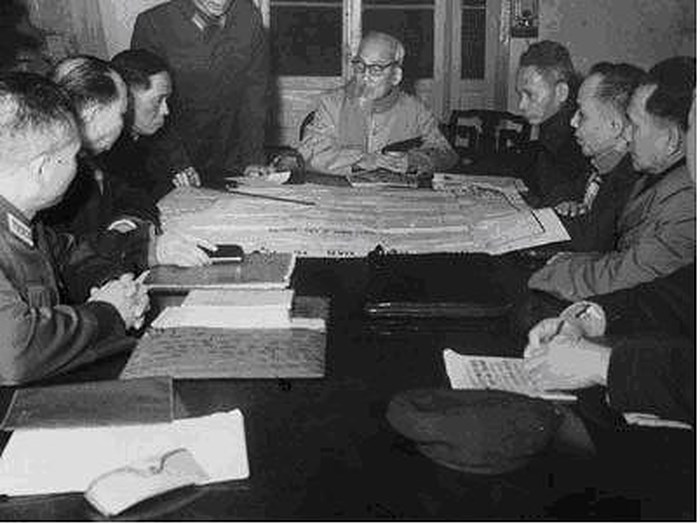
Uncle Ho and the Politburo met to discuss the 1968 Tet Offensive.
At the end of 1967, due to the increasing pressure of international public opinion, as well as many domestic economic and social problems and the rising anti-war movement of the American people, at the National Constitutional Convention held in San Antonio, US President LB Johnson had to declare: "The United States is ready to stop all air and naval bombardment of North Vietnam when this initiative leads to effective debates. Of course, we assume that during the time those discussions take place, North Vietnam does not take advantage of the cessation or limitation of bombing" (4). LB Johnson's declaration of a conditional cessation of bombing was called by international public opinion as "Antonio's Formula”. On October 29, 1967, in order to take the initiative and demonstrate our goodwill to public opinion, in a statement on January 28, 1967, on behalf of the Government of the Democratic Republic of Vietnam, Minister Nguyen Duy Trinh continued to declare: “After the US unconditionally ended the bombing and all other acts of war against the Democratic Republic of Vietnam, the Democratic Republic of Vietnamwill talkwith the United States on related issues”(5).
In parallel with diplomatic activities, on the southern battlefield, our armed forces continued to step up military attacks. Implementing the 14th Central Committee Resolution on the Southern Revolution, along with the Khe Sanh front, on the night of January 30 to the morning of January 31, 1968, the Tet Offensive and Uprising took place throughout the South, directly attacking major cities such as Saigon, Hue... The offensive dealt a heavy blow to the US's invasion plot and "prestige". In a strategic defeat, on March 31, 1968, LB Johnson declared to the American people that he was ready to "open peace talks immediately" and "ready to send representatives to any forum, at any time, to discuss measures to end this brutal war". According to him: "There is no need to delay negotiations that can lead to an end to these protracted and bloody wars" (6). LBJohnson's statement has three basic contents: 1.Unilaterally stop bombing the North from the 20th parallel; 2.Not running for a second term; and 3.Accept negotiations with the Democratic Republic of Vietnam. Along with admitting that he was “looking for ways to de-escalate the war”, on the first point, the US President pointed out: “The area that we no longer bombed accounts for approximately 90% of the population and most of the territory of North Vietnam, except for the area north of the demilitarized zone” (7). To confirm his words, LB Johnson also sent Averell Harriman, considered a talented diplomat, who had a lot of experience in the negotiations between the US and Russia during World War II, to represent the US President and assigned A. Harriman the task of “seeking peace”. This can be seen as a manifestation of strategic changes in US policy on the Vietnam issue. The US accepted to de-escalate the war, agreed to negotiate to explore and find a political solution.
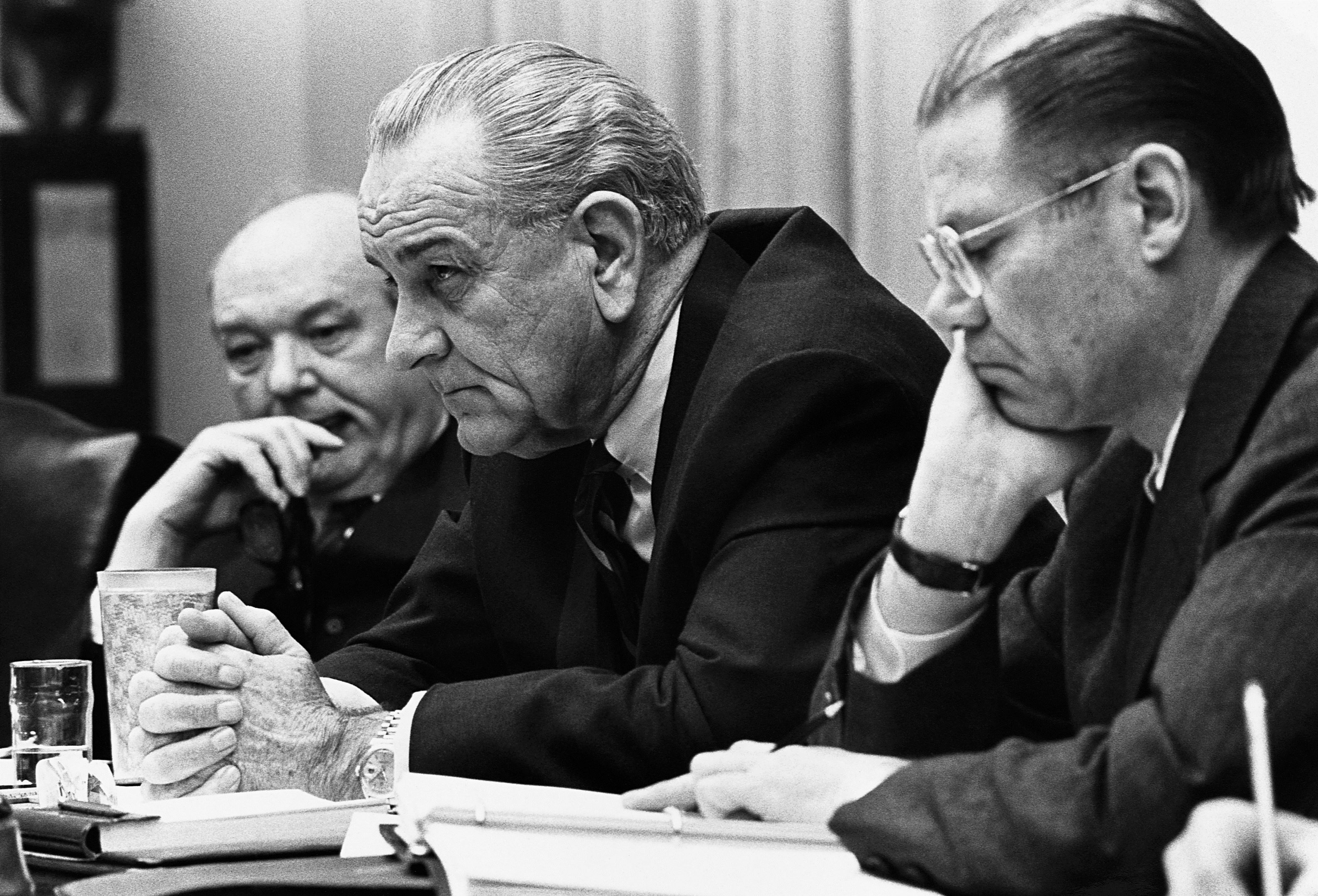
US President Johnson meets with advisers after the 1968 Tet Offensive
On May 13, 1968, after a period of debate and location selection, the first bilateral conference between the Democratic Republic of Vietnam and the United States officially held its first session at the International Conference Center on Kléber Street, Paris, France. Because we had not yet gained absolute superiority on the battlefield, the main motto of our delegation at that time was to force the US to unconditionally stop bombing the North before discussing other issues. On October 21, 1968, our Government delegation officially issued a notice to the US side requesting the US to stop bombing and other acts of war against the Democratic Republic of Vietnam and organize aFour-party conferenceto find a political solution to the Vietnam problem. The United States accepted that proposal. The presence of the National Liberation Front of South Vietnam Negotiation Delegation as a legitimate, official political entity not only raised the Front's position, contributed to making the world understand more about the just struggle of our people, but also strengthened the military, political, and diplomatic coordination between the two regions of the South and the North.It was a victory of strategic significance..
Although the negative reactions from the Nguyen Van Thieu government were anticipated, the US's acceptance of the Four-Party Conference with the presence of a delegation from the National Liberation Front of South Vietnam gave rise to serious disagreements between the US and the Republic of Vietnam's ruling class. LB Johnson once bitterly admitted: "When we reached an agreement with Hanoi, the harmony with President Thieu was broken" (8).
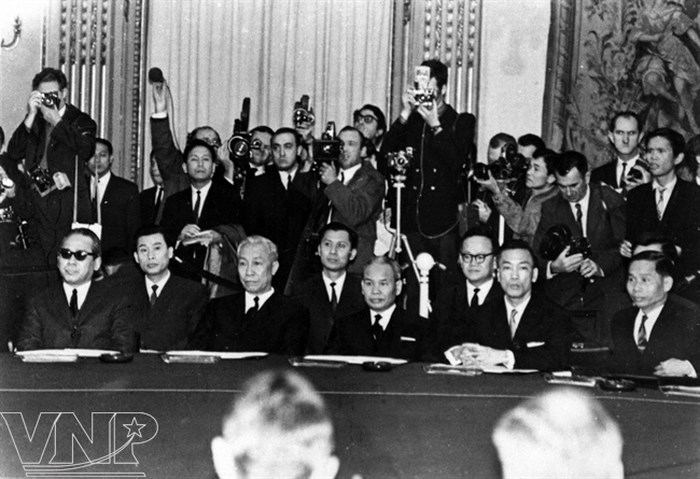
Delegation of the Democratic Republic of Vietnam attending the opening session of the Four-Party Conference on Vietnam in Paris on January 25, 1969
Faced with the rapid developments of the negotiations, the Nguyen Van Thieu administration wanted to extend the time to talk directly with Hanoi and relied on the support of some forces in the US Republican Party to reject LB Johnson's statement on ending the bombing and opening a four-party conference to resolve the Vietnam issue. The reason given by Saigon was that it needed time to seek the opinion of the National Assembly. Furthermore, Thieu did not accept the National Liberation Front as a party to the negotiations and suggested that "procedural issues" must be resolved before the meeting could take place. In his statement in Saigon, Thieu also made it clear that he was not ready to send a delegation to Paris to attend the conference as the US had requested.
Faced with that attitude of the Nguyen Van Thieu government, unable to miss the opportunity for peace, the US decided to “go it alone”. LB Johnson ordered an end to air, naval and artillery bombings of North Vietnam. On the other hand, to reassure Thieu, Washington also explained that the participation in negotiations of the National Liberation Front of South Vietnam did not mean legal recognition of this Front. Under pressure from the US, on December 8, 1968, the Nguyen Van Thieu government had to send a delegation to Paris to participate in the peace talks and directly witness part of the diplomatic struggle that was intelligent, skillful, and principled, maintaining our sovereignty and national independence. Saigon understood that: When the Americans accepted negotiations, stopped bombing and later accepted to withdraw troops from South Vietnam, the end of a pro-US puppet government was certainly not far away.
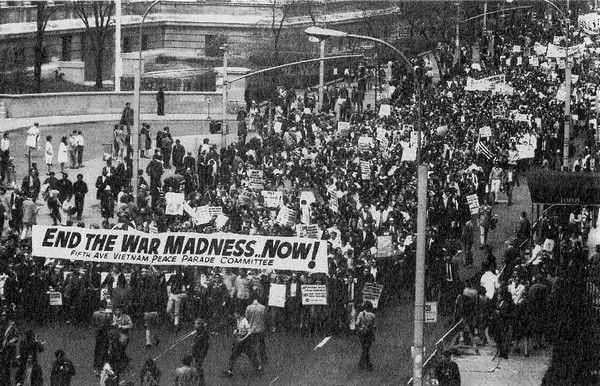
Anti-Vietnam War protest in New York in 1968
2. Paris Conference: Commitments - Non-commitments
On November 6, 1968, Richard Nixon, the Republican candidate, was elected President of the United States with 43.3% of the vote in a situation where the United States was bogged down in Vietnam, and its political interests and economic position in the world were seriously declining. Like his predecessor, R. Nixon soon realized the deadlock and disappointment in the war being pursued in Vietnam but still did not easily admit defeat. After Tet Mau Than, R. Nixon became even more convinced that the war could hardly be “won” if only using force. After becoming president, the head of the White House issued the “Nixon Doctrine” on Guam Island on July 25, 1969. In the face of defeat on the battlefield and the need to withdraw troops sooner or later, the “Nixon Doctrine” was based on three principles:The Power of America;Share responsibilityandNegotiate from a position of strengthAt the same time, on the international level, the US sought to “improve” relations with the Soviet Union and China in order to find the most beneficial political solution to the “Vietnam Problem”, cutting aid to Vietnam and on the other hand, taking advantage of these countries to influence the Vietnam-US negotiations in Paris.
Applying the principles of the “R. Nixon Doctrine” to the ongoing war in Vietnam, the White House launched the “Vietnamization of the war” strategy to reduce America’s commitment to its allies, requiring allies to gradually replace American troops fighting directly on the battlefield to gradually withdraw troops home... The ultimate goal was to maintain a pro-American government in South Vietnam. In fact, this policy also aimed to appease the indignation of the American people, reduce the burden of war but continue to maintain influence in the South through weapons aid and military advisors. Faced with the increasingly weakened situation and inevitable failure of the puppet government, the US made compromises, attracting a number of countries to share and maintain interests and influence in Southeast Asia while continuing to permanently divide our country.
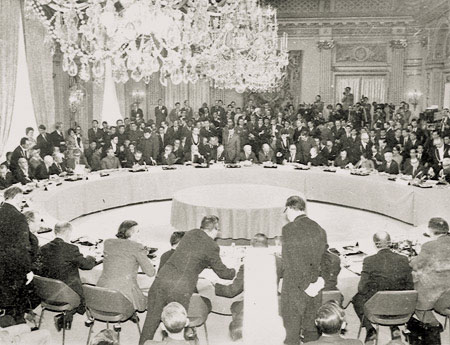
Overview of the Paris Conference on ending the war in Vietnam
However, with his belligerent nature, in 1970-1971, R. Nixon expanded the war to all three Indochinese countries to prevent the development of the revolutions in Vietnam, Laos, and Cambodia and gain strength at the negotiating table. After Tet 1968, American public opinion increasingly believed that sending troops to invade Vietnam was a serious mistake. The anti-war movement had strongly penetrated American intellectuals and university students. Many Americans believed that inflation, urban problems, and unrest in universities... were all consequences that American society had to bear due to the impact of the "Vietnam War". For the American economy, in 1969-1970, the inflation rate reached its peak. In the first year of Nixon's administration, the budget deficit was $3 billion and increased to $23 billion in 1971. That economic situation caused the President of the Bank of America, Louis B. London, to speak before the Senate Foreign Relations Committee on April 15, 1971: "It seems to me that the time has come to make it clear: The war has seriously damaged the American economy, has fanned the flames of inflation, has dried up assets that are extremely necessary to overcome serious domestic problems... and has slowed down the growth rate of profits" (9). In addition, the war has affected the psychology and awareness of many American congressmen about the hopeless goals pursued by the Nixon administration. Since the Tet Offensive, this administration has had to continuously face fierce political struggles taking place in the legislative body.
On the diplomatic front, on May 8, 1969, the delegation of the National Liberation Front of South Vietnam proposed a comprehensive 10-point solution to the South Vietnam issue. These were the first basic principles in preparation for a series of diplomatic agreements aimed at signing an agreement to end the war and restore peace in Vietnam. In joint meetings and private meetings, the delegations of the two regions closely coordinated and continuously fought to continue to push the US down on key issues, forcing the US to unilaterally withdraw its troops anddeepen internal enemy contradictions. At the 21st session held on June 12, 1969, for the first time, the Southern delegation attended under the name of the Negotiation Delegation of the Provisional Revolutionary Government of the Republic of South Vietnam. In response to journalists' questions about this historic event, the spokesman for the American delegation repeated Cabot Lodge's words: "Who represents them is their internal affair." That admission by the American side made the Saigon government even more disappointed about its position in the negotiation process, but due to its heavy dependence on the United States, it could not openly oppose the United States.
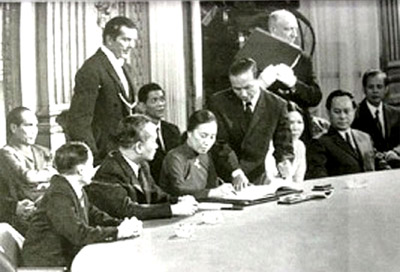
Mrs. Nguyen Thi Binh at the Paris Agreement signing ceremony on January 27, 1973
In order to implement the neo-colonial policy in South Vietnam, during the early negotiations, the US side always tried to avoid discussing the existence of the Saigon government. During the diplomatic struggles in 1971, our delegation persistently demanded the removal of Thieu and then the removal of the Nguyen Van Thieu ruling group, forcing H. Kissinger to also talk about establishing an independent organization for general elections. This was one of the key issues of the peace negotiations. By October 1972, with the mottowin step by step, we came to a bold and flexible decision "not to demand the removal of the Thieu government but to maintain the status quo of the two governments, only agreeing on some major principles such as the two southern sides will negotiate to resolve internal problems in the South, establish a government structure to urge and supervise the implementation of the agreement and organize general elections" (10).
That strategic concession by our delegation caused the relationship between Washington and Saigon to become even more deeply fractured. In fact, while reaching that agreement, the US side also underestimated Thieu's reaction. They believed that an agreement in which the pro-US government would still exist and be recognized in legal documents would be enough to ensure that Thieu would consider it a remarkable victory and that other issues would only be of secondary importance. However, along with the decision to sign a ceasefire agreement, the US policy of withdrawing troops from the southern battlefield made the Saigon puppet government feel even more disappointed and lose both material and spiritual support. Talking to the US Ambassador in Saigon Ellsworth Bunker, Thieu lamented: “This is a matter of life and death for South Vietnam and the 17 million people of South Vietnam. Our position is very unfortunate. We have been very loyal to the US and now we feel that we are being sacrificed... If we accept the document as it is, we will commit suicide” (11). In fact, Thieu sent Bui Diem to Washington to explain to the US side that: “the problem of North Vietnamese troops in the South is a matter of life and death for us. It may be too late now to influence them... But as the proverb says, while there is life, there is hope” (12). For its part, in the first months of 1972, the US also actively carried out diplomatic activities to “normalize” relations with the Soviet Union, China... and wanted to resolve the “Vietnam problem” and other countries on the Indochina peninsula through the intermediary role of a number of countries (13). But in the end, "Even the Nixon clique had to admit that if it did not talk to Vietnam, the US would have no way out of the deadlock" (14).
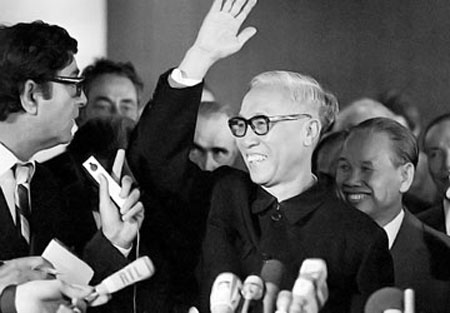
Special Advisor Le Duc Tho with a victorious smile at the Paris Conference.
On the Vietnam battlefield, by September 1970, the US had unilaterally withdrawn 140,000 troops. In 1971, the US continued to withdraw troops from the Vietnam battlefield. That action by the US changed the balance of power on the battlefield. The fighting power of the army was seriously reduced. In addition, the strategic offensive of our armed forces in the Spring - Summer of 1972 on the Binh Tri Thien and Tay Nguyen fronts further weakened the enemy. The Saigon government's "Vietnamization of the war" strategy with the support of US advisors and modern means of war began to show signs of crisis. Regarding the significance of the 1972 offensive, comrade Le Duan assessed: “Although the victory was still limited... our position and strength were much better and stronger than before. Most of the main units returned to the South, proactively attacking the enemy in important strategic areas” (15).
To save the situation on the southern battlefield, R. Nixon re-mobilized the US military forces, re-ignited the war of destruction in the North, dropped mines to blockade Hai Phong port and other important ports in order to block our supply routes. In September 1972, based on an assessment of the domestic and international situation, our Party's Politburo advocated reaching a diplomatic solution before the US presidential election. On October 4, 1972, the Politburo telegraphed the delegation in Paris to temporarily put aside some other requests regarding the South's internal affairs in order to quickly end the war. If we could end the US military involvement in the South, then in the future struggle with the puppet government, we would have the conditions to achieve those goals and could achieve greater victories (16).
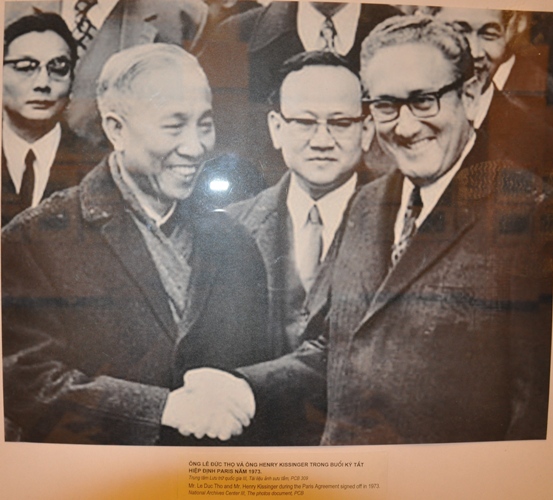
Mr. Le Duc Tho and Mr. Henry Kissinger at the signing ceremony of the Paris Agreement in 1973
Thoroughly grasping the above spirit, closely coordinating with the negotiating delegation, we urgently prepared the Draft Agreement from within the country. On October 8, 1972, on behalf of our Government, advisor Le Duc Tho handed over to H. Kissinger theDraft Agreement on Ending the War and Restoring Peace in Vietnam. In separate meetings, a fierce diplomatic campaign took place on each content and clause of the agreement. By the end of October 1972, "applying Uncle Ho's teachings to negotiations, we came up with an appropriate plan."not simultaneously demanding to resolve the two demands of the US leaving and the puppet regime falling, but focusing on demanding the US leaving first, thereby making the negotiations move quickly from October 1972”(17). At the end of October, the agreement was completed and the two sides agreed to sign it on October 31, 1972 before the US presidential election. Worried that the opposition of the Saigon government could slow down or even disrupt the “peace plan”, from October 19 to 23, 1972, at the request of R. Nixon, Kissinger went to Saigon and delivered to Nguyen Van Thieu R. Nixon’s letter dated October 16 with the commitment: “In the period following the ceasefire, you can be completely assured that we will continue to provide your government with the fullest support, including economic aid and any military aid in accordance with the ceasefire terms of this agreement”(18). However, in Saigon, the Nguyen Van Thieu government reacted strongly to the agreements of its American masters and upon learning the content of the draft agreement, immediately demanded 69 points were revised (19). Taking advantage of that opportunity, using the excuse of “having difficulties with Thieu”, the US side asked our delegation to “negotiate further” and proposed to postpone the signing date of the agreement while pledging not to request any further changes after reaching an agreement in this meeting.
Faced with such a fickle attitude, in order to gain international public opinion and continue to heighten the political and diplomatic struggle, on October 27, 1972, our Government publicly announced the negotiation situation in Paris and informed the public about the agreement that the parties had reached in October. At the following meeting, along with the request to change some principled contents, H. Kissinger also suggested removing the paragraph that said: “The United States is not committed to any political tendency or individual in the South, and does not seek to impose a pro-US government in Saigon” (20). Faced with our resolute struggle and fear of strong public opposition, on October 26, 1972, H. Kissinger had to declare: “Peace within reach”. Because of the ambition to continue to prolong or break the negotiations, the Nguyen Van Thieu government strongly opposed the content of the agreement. The conflict between Washington and Saigon exploded openly. Thieu always felt abandoned by the US in diplomatic agreements. Understanding Thieu's situation, the US side "informed Thieu that publicizing the secret talks at this time would neutralize the growing opposition to the war, help maintain domestic support in the United States, and prevent the passage of Congressional bills that would be harmful to the Vietnamization program" (21).
Although the US government repeatedly reassured them, in their perception, Nguyen Van Thieu's government still considered it a "surrender agreement". To continue to gain Thieu's trust, on October 29, 1972, the head of the White House affirmed: "But what is more important than what we wrote in the agreement on that issue is what we will do in case the enemy re-invades. I absolutely assure you that if Hanoi does not comply with the conditions of this Agreement, I will resolutely take the fastest and most fierce retaliation" (22). Seemingly unable to rest assured with the commitments, on November 18, 1972, Thieu sent special envoy Nguyen Phu Duc to meet R. Nixon to both present the viewpoint of the Republic of Vietnam government and find ways to put pressure back on the US authorities.
In that context, the diplomatic struggle was extremely tense. To pressure us to make concessions, at a private meeting with advisor Le Duc Tho and Minister Xuan Thuy on November 24, 1972, H. Kissinger presented R. Nixon's ultimatum: "Unless the other side shows a willingness to pay attention to our reasonable concerns, I instruct you to stop negotiations and we will have to resume military activities until the other side is ready to negotiate on honorable terms" (23). In the face of our principled struggle, the US unilaterally stopped negotiations but did not dare to abandon negotiations and on the other hand could not reject Thieu's proposals. Not being able to easily eliminate the political regime in South Vietnam, R. Nixon - H. Kissinger implemented a two-faced policy of both comforting and appeasing Thieu and at the same time informing Thieu about the possibility of strong opposition from many members of the US Congress to the belligerent attitude and prolonging the war of the Saigon government.
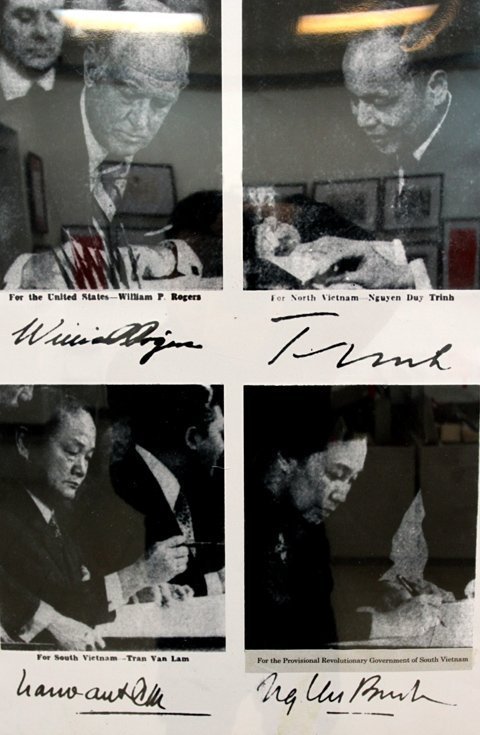
Representatives of the four parties (Democratic Republic of Vietnam; Provisional Revolutionary Government of South Vietnam; United States; Republic of Vietnam) signed the Paris Agreement (January 27, 1973)
Faced with the deadlock in negotiations, from December 18 to 29, 1972, in an attempt to use military force to crush our will, the US launched a strategic B-52 raid on Hanoi, Hai Phong and many other cities and densely populated areas, brutally massacring our people. R. Nixon calculated that, internally within the US, the bombing could appease the right-wing faction, preventing them from colluding with Saigon to oppose R. Nixon. The raid also aimed to reassure Thieu about the US's strength, demonstrate the US's commitment, and then pressure Thieu to sign the agreement soon. In addition, "For other allies, the bombing was to demonstrate that the US withdrew from the war as a victor, not surrendering, not abandoning its allies" (24). But the most basic and sinister plot is that the US wants to use military power to put maximum pressure on us politically and diplomatically in order to force Vietnam to accept an agreement under US conditions. After the devastating bombing, Washington also hoped that it could break our fighting will and strength, making our army and people no longer have enough forces to continue supporting the southern battlefield, carrying out the cause of national reunification. However, our army and people made a "Dien Bien Phu in the air" and forced the US to resume negotiations.
By mid-January 1973, the official text of the agreement had been agreed upon by the parties with the same basic content as the draft agreement proposed by the Government of the Democratic Republic of Vietnam in October 1972. Realizing that the risk of being abandoned by the US was becoming increasingly apparent, the Nguyen Van Thieu government strongly opposed the peace negotiation process. In order to quickly overcome the opposition of the Saigon government and to end the war soon, focusing its efforts on dealing with domestic issues, especially information about the incident.Watergateincreasingly widespread, on January 5, 1973 R. Nixon continued to use the "traditional card" which was to both pledge to strongly support Thieu and threaten: "As we enter the upcoming negotiations, I hope that our two countries will present a united front... If you decide, and I believe you will decide, to go with us, then I pledge to you that I will continue to support the Republic of Vietnam in the post-reconciliation period and that we will react with full force if North Vietnam violates that reconciliation" (25). On January 17, 1973, in a letter to Nguyen Van Thieu, the US President continued to declare: “I would like to reiterate what I have told you in my previous letters: The freedom and independence of the Republic of Vietnam remains a supreme goal of US foreign policy... I would like to once again declare the commitments in this letter: First, we only recognize your government as the sole legitimate government in Vietnam; Second, we do not recognize the right of foreign troops to stay on the land of South Vietnam; Third, the United States will have strong reactions to violations of the agreement” (26).
Those are just some excerpts from the 27 letters and messages that R. Nixon sent to the Thieu government in three years until he had to resign on August 9, 1974 because of the scandal.Watergate. Although the contents of those letters mentioned many issues, there was always a basic content that the United States committed to support the Republic of Vietnam government comprehensively in terms of politics, military and economy. However, those commitments were far from historical reality, especially the content of the agreement that the Nguyen Van Thieu government had to accept. In the perception of the Saigon government, the Paris Agreement consisted of 9 chapters and 23 articles, then Article 3b and Article 5 of Chapter II could truly be considered a verdict.
Realizing the hesitation of Nguyen Van Thieu's group, on January 19, 1973, R. Nixon sent Thieu another letter delivered by General Alexander Haig. In it, he informed Thieu: "I have decided to definitely initial the agreement on January 23, 1973 in Paris. If necessary, I will do it alone" (27). In the following meetings, A. Haig even told Nguyen Van Thieu and Hoang Duc Nha that: "if the agreement is not signed, the United States will take brutal measures". Immediately, both understood the "historical significance" of that statement, referring to the events of 1963. With no other choice, Nguyen Van Thieu had to accept and only asked for suggestions to correct a few minor points. On January 20, 1973, the day R. Nixon entered the White House for his second term, the US side again pledged to the Nguyen Van Thieu government: "The United States recognizes your government as the only legitimate government in Vietnam" and at the same time requested Thieu to accept the content of the agreement and give his opinion no later than 12 noon on January 21, 1973. In fact, it can be considered an ultimatum from the R. Nixon government to the Saigon puppet government. In Paris, only 2 days later, Kissinger initialed the document and exactly 4 days later, on January 27, 1973, the Saigon government also had to sign the agreement. In his speech on radio and television on January 23, 1973, the US President said: "An honorable peace has been achieved" (Peace with Honor)(28). But, for Nguyen Van Thieu's group, it was truly "A bitter peace"(A Bitter Peace)(29). And what R. Nixon thought, with the agreement, the Republic of Vietnam had won a precious right, that is, "the right to decide its own future" (30) was actually a merciless abandonment and abandonment of "responsibility" for Saigon. Thus, as Westmoreland, former Commander-in-Chief of the US military in South Vietnam, admitted: "The fate of South Vietnam was decided when Kissinger signed the ceasefire agreement in place, withdrew US troops and allowed thousands of regular North Vietnamese soldiers to stay in the South" (31). It is also necessary to add that, when asked by Ehrlichman, one of R. Nixon's assistants: "How long do you think South Vietnam can survive with this agreement?", H. Kissinger replied: "I think if they are lucky, they can hold out for a year and a half" (32).
Thus, after many times going against its commitments, the United States had to make a final commitment, a written commitment to the issue of ending the war in Vietnam. For us, the strategic goal of signing the Paris Agreement has been fully realized. Because, along with forcing the United States and related parties to recognize independence, sovereignty, unity and territorial integrity, "the important thing of the Paris Agreement is not to recognize two governments, two armies, two controlled areas, moving towards the establishment of a three-component government, butThe key is that the American troops must leave and our troops must stay.The North-South corridor was still connected, the rear was linked with the front to form a unified continuous strip; our offensive position was still stable.Our intention is to maintain our position and strength in the South to continue to attack the enemy.”(33). Those are the two greatest victories of Vietnamese diplomacy and Vietnamese intelligence in the process of signing the Paris Agreement.
3. The end of the war and the fate of the Saigon government
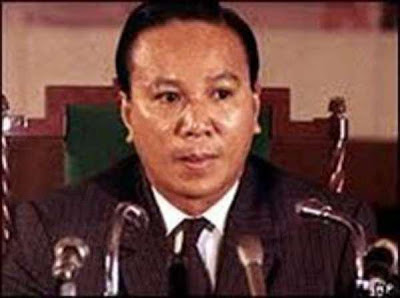
President of the Republic of Vietnam Nguyen Van Thieu announced his resignation on April 21, 1975.
In the early 1970s, due to the impact of the oil crisis, the economies of the capitalist world, including the United States, fell into a serious recession. Faced with intense domestic pressure over the issue of American soldiers being killed and captured in the "Vietnam War" as well as the increasingly widespread anti-war movement around the world, along with the battlefield in the South, the United States had to withdraw its troops from Thailand and gradually reduce aid to its vassal states.
Although disappointed with the Saigon political system and the weak combat capabilities of the puppet army, Washington still harbored the ambition to maintain the puppet regime of Nguyen Van Thieu in South Vietnam. Along with the 8-year post-war economic plan (1973-1980) aiming to make the Southern economy superior to the socialist Northern economy, in terms of politics and military, "The consistent plot of the US in South Vietnam is to continue to use the Saigon puppet government as a tool to implement neo-colonialism, find every way to eliminate the liberated zones and our people's armed forces, eliminate the people's government, turn the South into a separate pro-American country, receiving US military, economic, and financial aid so that the US can still cling to the South for a long time and avoid the risk of directly participating in a large-scale war" (34).
In order to strengthen the puppet army, from October 1972, on the one hand, the US made promises and commitments in Paris, on the other hand, it implemented the plan "Enhance Plus"Establishing an air bridge, massively increasing weapons and war equipment for the Saigon government. Within 2 months, the White House sent to Vietnam 260,000 tons of war equipment worth nearly 2 billion USD. Relying on American aid and advisors, the Saigon puppet government prepared the "Ly Thuong Kiet Plan", implementing the "Flooding the Territory" campaign to win people and occupy land. Right at the time the Paris Agreement was about to be signed, the Nguyen Van Thieu government also sent troops to occupy Cua Viet port (Quang Tri) and many other areas. However, those armed actions could not conceal their weakening position on the battlefield. Based on strategic analysis, after signing the Paris Agreement, our Party Central Committee assessed: Once the US withdrew its troops from the South, it would be difficult to return. However, if they intervened again to some extent, it would not change the war situation.
During the long negotiations in Paris, on the southern battlefield, the US transferred most of its military bases to the Saigon government. By 1973, the total number of puppet troops had reached 1.1 million, accounting for 50% of the youth between the ages of 18 and 35. The Pentagon also continuously strengthened the puppet government's air force and heavy artillery. “Starting with only 75 old helicopters in 1968, the Republic of Vietnam had 657 of the latest models by July 1972. This gave the Republic of Vietnam one of the largest and most modern helicopter fleets in the world. In addition, the air force consisted of 740 aircraft, the fourth largest in the world. In 1971, the Army of the Republic of Vietnam received at least 1,000 artillery pieces, 1,650 heavy mortars, over 1,000 M.113 armored personnel carriers, 300 tanks, and an advanced communications system to tie the disparate army together. The amount of equipment that army received is a mystery because after the US withdrew, the US left behind a huge amount of material” (35). Pursuing a neocolonial policy with the basic plot of maintaining the existence of the Saigon puppet government and permanently dividing our country, the US also changed the names of many military agencies to civilian ones while still maintaining 24,000 military advisors and civilian staff in the South.
On April 3 and 4, 1973, Nguyen Van Thieu went to the United States to meet President R. Nixon in San Clemente. At the meeting, R. Nixon pledged to continue to provide military support to the Saigon government. Immediately afterwards, the United States resumed reconnaissance flights over the skies of North Vietnam and suspended meetings of the Joint Economic Committee on rebuilding North Vietnam. In May 1973, the Politburo of the Central Committee of the Vietnam Workers' Party stated: "The US imperialists continue to maintain a certain military commitment and continue to assist the Saigon puppet government so that its lackeys are strong enough to stand firm and deal with the North, while ensuring that the US will remain in the South for a long time, avoiding the risk of having to directly get involved in a new war in the South" (36). The US condoned and, together with the Saigon government, systematically sabotaged the Paris Agreement. From February 1973 to mid-1974, under the command of American advisors, the puppet army organized 34,266 large-scale attacks to occupy liberated areas and 216,000 pacification operations in controlled areas.
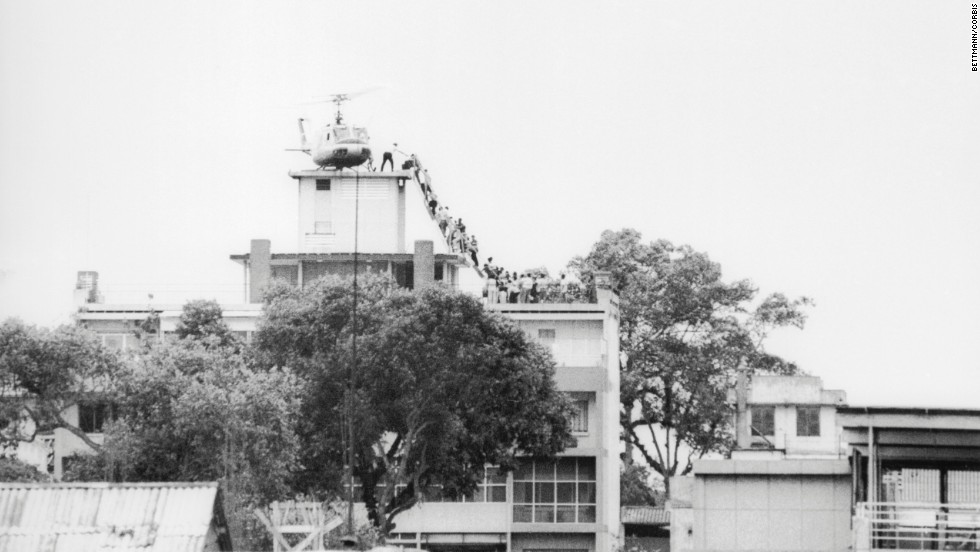
The puppet government evacuated and fled Saigon on April 30, 1975.
But by 1974, the political and economic situation in the US had become increasingly unstable. Among the many reasons, theWatergatehas plunged American politics into a serious scandal.Watergateis considered the most vicious political corruption in American history. This scandal caused a profound crisis of power that made R. Nixon unable to save his honor and eventually had to resign as president. R. Nixon's political failure caused the Nguyen Van Thieu government to lose its last reliable support in the umbrella of American protection. The relationship between Washington and Saigon from then on fell into a state of crisis and serious distrust. However, to reassure and maintain "honor" with its allies, less than 24 hours after succeeding R. Nixon, the new US President Gerald Ford sent a message to Thieu and affirmed: "The commitments that our country promised to your country in the past are still valid and will be fully respected during my term. These commitments of mine are especially suitable for the Republic of Vietnam in the current conditions" (37).
In fact, the political situation in the United States did not allow the G. Ford administration to continue to maintain a high level of aid to the puppet government. Since January 2, 1973, the US House of Representatives and the US Senate passed a resolution to cut all funding for any US military activities in Indochina except for a limited budget for troop withdrawal and repatriation of prisoners of war. In the dire situation of the South Vietnamese government, in June 1974, General John Murray called the Pentagon: “If aid remains at $750 million, Saigon will only be able to defend a portion of its territory. If it drops any further, it will mean the abolition of the Republic of Vietnam” (38). The report of the puppet General Staff sent to Nguyen Van Thieu in 1975 also pointed out the “vital importance” of US aid: “If the US provides 1.4 billion dollars in aid, Saigon will control the entire South; 1.1 billion dollars, Saigon will lose half of Military Region I in the North; if only 900 million dollars, it will lose the entire Military Region I and Military Region II; if only 600 million dollars, it will only control half of Military Region III from Bien Hoa to Military Region IV” (39). In fact, US aid to the Saigon government decreased from 2.27 billion dollars in 1973 to 1.03 billion dollars in 1974 and 1.45 billion dollars in 1975.
In parallel with the diplomatic struggle, to prevent the US and the Saigon government from constantly violating the terms signed in the Agreement, our armed forces mastered the strategic offensive position, defeating the encroachment operations of the Saigon army. In July 1973, the Central Executive Committee of the Vietnam Workers' Party issued Resolution XXI, continuingaffirm the path of revolutionary violence, advocating stepping up the struggle on three military, political and diplomatic fronts, while proactively preparing for the possibility of waging revolutionary war across the southern battlefield.

From the reality of the battlefield and analysis of the international political situation, realizing that some countries with ambitions to intervene in the Vietnam issue could not immediately take concrete measures and that the US was unlikely to send troops back to Vietnam, from September 30 to October 8, 1974, the Politburo met to discuss the policy of liberating the South and made the assessment: "At this time we have the opportunity... This is the most favorable opportunity for our people to completely liberate the South, gain complete victory for the national and democratic revolution, and at the same time help Laos and Cambodia complete the cause of national liberation" (40). After the second meeting from December 8, 1974 to January 8, 1975, the Politburo set out the strategic determination to completely liberate the South in the two years of 1975-1976, and then after successive victories, graspedNew strategic opportunityOn March 25, 1975, the Politburo and the Central Military Commission again made the determination to liberate the South.before the rainy season1975(41).
On January 6, 1975, when Phuoc Long province was liberated, to reassure public opinion, US Secretary of Defense James Schlesinger still stated: "This is not yet a massive offensive by North Vietnam" (42). On January 22, 1975, before the rapid developments on the battlefield in South Vietnam, President G. Ford still declared: "There will be no other action than to increase aid to Saigon. The United States will not intervene without going through constitutional and legislative procedures" (43). However, after Phuoc Long, the Central Highlands campaign, whose opening victory had a decisive significance, Buon Ma Thuot on March 11, opened a new era for our country's revolution. On March 21, we launched the Hue - Da Nang campaign. On March 25, 1975, Thieu wrote a long letter to G. Ford with urgent words:
“As I write this letter to you, the military situation in South Vietnam is extremely urgent and is becoming more serious with each passing hour...
Under firm commitments at that time, we were promised that the United States would retaliate quickly and severely for any violation of the agreement by the enemy.
We regarded those pledges as the most important guarantee of the armistice. We believed that pledges were vital to our survival.
Dear President,
At this extremely urgent moment, when the life of free South Vietnam is in danger and peace is seriously threatened, I solemnly request that you take the following two necessary measures:
- Ordered B-52 aircraft to bomb enemy troop concentrations and logistics bases in South Vietnam in a short but intense period of time, and
- Provide us urgently with the means necessary to prevent and repel the attack.
...
Dear President,
Once again, I would like to appeal to you, to the prestige of American foreign policy, and especially to the conscience of the American people.”(44)
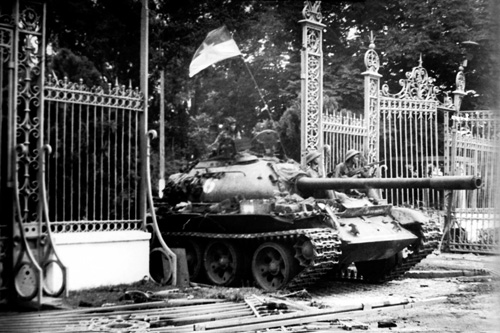
The Vietnam Liberation Army entered to liberate the Independence Palace on April 30, 1975.
In desperation, in order to maintain its own existence, the Nguyen Van Thieu government most clearly revealed its reactionary nature, going against the interests of the nation. G. Ford received Thieu's letter and the distress letter from the President of the Senate and the House of Representatives of the Republic of Vietnam but did not receive any response. He also decided to keep those letters without informing the government and the two houses. Unable to continue on the dead-end tunnel of the "Vietnam War" and continue to endure the pressure of opposing the war from many sides at the same time, G. Ford boarded a plane to Palm Springs for a vacation and only 4 days later, Da Nang, the largest military alliance in the Central region of the Saigon puppet government, fell. The path to Saigon for our army was wide open. On April 16, G. Ford ordered the evacuation of Americans from Saigon and sent an urgent letter to Leonid Brezhnev asking the Soviet leadership to persuade Vietnam to let the Americans carry out the evacuation campaign from South Vietnam. The fate of the Saigon government was only a matter of days. However, some forces in the Saigon government still hoped that a “peaceful solution” could be reached and that the US could mobilize B-52s to carpet bomb, preventing the rapid advance of our army.
Two days after Nguyen Van Thieu resigned, realizing that the political fate of the South Vietnamese government was beyond saving, on April 23, 1975, at the University of New Orleans, US President Gerald Ford had to admit in despair: “The war in Vietnam is over for America. America can no longer help the Vietnamese people, they must face whatever fate awaits them” (45).
And on April 30, 1975, when our main army corps advanced to liberate Saigon, for the "honor" and interests of the United States, the Washington authorities abandoned the Saigon puppet government just as they had abandoned the Lon Nol puppet government on April 17, 1975. For many reasons, in the final years of the "Vietnam War", in order to continue to maintain American influence and save the existence of the Saigon puppet government, the United States continuously made commitments, going against its commitments and historical reality shows that, with its powerful military and economic potential, the United States cannot always fulfill its commitments to its "allied" countries.
In that process, as H. Kissinger admitted, US diplomacy “was damaged and needed time to regain its balance”. According to his justification, due to not being able to maintain its position, the US had to “go from one concession to another while North Vietnam did not change its diplomatic goals but only slightly changed its diplomatic stance” (46). The final result was that, before the iron determination “Nothing is more precious than independence and freedom"of our people; by knowing how to combine national strength with the strength of the times, grasping the right revolutionary opportunity, thoroughly exploiting contradictions within the enemy ranks, ending the war at the right time..., our army and people defeated the "Vietnamization of the war" strategy, causing the collapse of the pro-American puppet government in South Vietnam, liberating the South - reunifying the country.
Note
1. Communist Party of Vietnam:Complete Party documents, National Political Publishing House, Hanoi.2004, Volume 28, p.174.
2. NewspaperPeople, January 28, 1967.
3. Trinh Ngoc Thai:President Ho Chi Minh and the Paris Conference; in the Ministry of Foreign Affairs:Diplomatic front with Paris talks on Vietnam, National Political Publishing House, Hanoi.2004, p.78
4.Pentagon Papers, Gravel Edition, Volume 4, p.206.
5. Luu Van Loi:Vietnam diplomacy(1945-1995), People's Police Publishing House, 2004, pp.228-229.
6. Larry Berman:No Peace, No Honor - Nixon, Kissinger, and Betrayal in Vietnam, Published by Simon & Schuter, New York, 2002, p.14.
7. Larry Berman:No Peace, No Honor..., p.14.
8. According to Luu Van Loi:Vietnam diplomacy(1945-1995), ibid, p.242.
9. Gabriel Kolko:Anatomy of a War, People's Army Publishing House, H., 2003, p.388.
10. Luu Van Loi:Kissinger confronts Le Duc Tho; in the Ministry of Foreign Affairs:Diplomatic front..., Ibid, p.114.
11.New York Times, Sunday, April 30, 2000.
12. AJLangguth:Our Vietnam - The War 1945-1975, Simon & Schuster Publishing House, 2000; quoted by Luu Doan Huynh:Why did the US use B-52s before signing the Agreement??; in the Ministry of Foreign Affairs:Diplomatic front..., Ibid, p.213.
13. Kit-Sing-Go:Unpublished top secret meeting minutes, Thanh Nien Publishing House, H., 2002.
14. Le Duan:Letter to the South, Truth Publishing House, H., 1985, p.280.
15. Le Duan:Letter to the South, Ibid, p.302.
16. Doan Huyen:Beat America: Fight and negotiate, in the Ministry of Foreign Affairs:Diplomatic front..., Ibid, p.141.
17. Nguyen Thanh Le:Looking back at the Paris talks on Vietnam; in the Ministry of Foreign Affairs:Diplomatic front..., Ibid, p.403.
18. Quoted from Nguyen Tien Hung - Jerrold L.Schecter:Secret files of the Independence Palace(The Palace File), Harper & Row Publishers, Los Angeles, 1987, p.1.
19. On this issue, Hoang Duc Nha, former “Presidential Secretary, Minister of Mass Mobilization and Repatriation” of the Republic of Vietnam, wrote: “Even during the period from October 12 to 17, 1972, Mr. Kissinger and Le Duc Tho agreed on an agreement text that the Republic of Vietnam had never been informed of. They believed that South Vietnam would not make things difficult: the North Vietnamese Communists believed their own propaganda that the Republic of Vietnam would not resist the United States, and the United States believed that because the Communists no longer demanded that the President of the Republic of Vietnam resign before peace, he would be willing to sign this agreement”; See Larry Berman:No Peace, No Honor - Nixon, Kissinger and Betrayal in Vietnam, Viet Tide Publishing, 2003, pp.16-17 (No Peace, No Honor - Nixon, Kissinger, and Betrayal in Vietnam, Published by Simon & Schuter, New York, 2002).
20. According to Luu Van Loi:Vietnam diplomacy(1945-1995), ibid, p.304
21. Larry Berman:No peace, No honor..., Ibid, p.163. Speaking on television on the occasion of the initial signing of the Paris Agreement, R. Nixon also reiterated this point of view.
22. Nguyen Tien Hung - Jerrold L.Schecter:Secret files of the Independence Palace, Ibid, p.2.
23. Luu Van Loi:Vietnam diplomacy(1945-1995), ibid, p.305
24. Luu Doan Huynh:Why did the US use B-52s before signing the Agreement??; in the Ministry of Foreign Affairs:Diplomatic front..., Ibid, p.215.
25. Nguyen Tien Hung - Jerrold L.Schecter:Secret files of the Independence Palace, Ibid, p.2.
26. Nguyen Tien Hung - Jerrold L.Schecter:Secret files of the Independence Palace, Ibid, p.4.
27. According to Luu Van Loi:Vietnam diplomacy(1945-1995), ibid, p.318
28. Larry Berman:No Peace, No Honor...,p.286.
29. Pierre Asselin:A Bitter Peace - Washington, Hanoi, and the Making of the Paris Agreement, The University of North Carolina Press, 2002.
30. Larry Berman:No Peace, No Honor...,p.286.
31. Dinh Nho Liem:The meaning of victory and some lessons; in the Ministry of Foreign Affairs:Diplomatic front..., Ibid, p.416.
32. Larry Berman:No Peace, No Honor...,p.8.
33. Le Duan:Letter to the South, Ibid, pp.359-360.
34. Le Duan:Letter to the South, Ibid, p.334.
35. Gabriel Kolko:Anatomy of a War, Ibid, p.437.
36. Communist Party of Vietnam:Complete Party documents, Vol. 34, p.177.
37. Quoted from Nguyen Tien Hung - Jerrold L.Schecter:Secret files of the Independence Palace, Ibid, pp.403-404.
38.History of the Communist Party of Vietnam, National Political Publishing House, Hanoi.1995, Volume 2, p.599.
39. Hoang Van Thai:The decisive years, People's Army Publishing House, H., 1985, p.140.
40. Le Duan:Letter to the South, Ibid, pp.360-362
41. Van Tien Dung:Great Spring Victory, People's Army Publishing House, 2003, p.124
42.History of the Communist Party of Vietnam, Ibid., Vol. 2, p.650.
43. Ministry of Foreign Affairs:Diplomatic front with Paris talks on Vietnam, Ibid, p.543
44. Quoted from Nguyen Tien Hung - Jerrold L.Schecter:Secret files of the Independence Palace, Ibid, pp.5-6.
45.History of the Communist Party of Vietnam, Ibid., Vol. 2, p.713.
46. Ministry of Foreign Affairs:Diplomatic front with Paris talks on Vietnam, Ibid, p.548.
Author:Prof. Dr. Nguyen Van Kim
Newer news
Older news